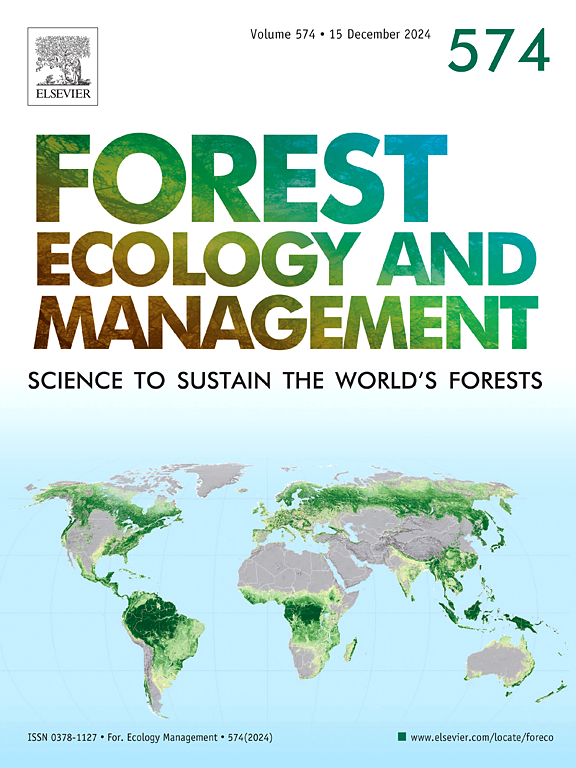Assessing tree migration potential: Growth deviations and range dynamics in eastern U.S. forests
IF 3.7
2区 农林科学
Q1 FORESTRY
引用次数: 0
Abstract
Understanding how tree species respond to climate change is essential for predicting future forest composition and ecosystem dynamics. This study evaluates the migration potential of tree species in the eastern United States by integrating growth residuals, absolute growth rate, and Importance Value (IV) as complementary indicators of species’ responses to environmental change. Growth residuals, which measure deviations from expected growth after accounting for tree size and environmental factors, provide insight into species’ recent responses to climate variability. Absolute growth rate reflects species productivity trends across latitudinal gradients, while IV serves as a historical baseline of species abundance and demographic stability. Using Random Forest modeling, we identified basal area, mean temperature, and mean precipitation as the most influential predictors of tree growth. We then applied Huisman-Olff-Fresco (HOF) models to assess latitudinal patterns in growth residuals, absolute growth rate, and IV. Our results revealed three major patterns: (1) species exhibiting northward growth residual peaks, suggesting poleward expansion potential; (2) species with southward growth residual peaks, indicating possible range contraction or climate limitations at northern edges; and (3) species with stable growth residuals, implying demographic inertia or localized climatic stability. Additionally, frequent mismatches between growth residuals and IV suggest that many species remain abundant in historical ranges despite shifting climatic suitability. While regeneration strategy is a key factor influencing species distributions, our findings suggest that it primarily affects IV rather than short-term growth responses. Wind-dispersed species, such as red maple and sugar maple, exhibited strong northward trends across all three metrics, whereas heavy-seeded species like sweetbay and slash pine had IV peaks farther south than their growth residuals, suggesting that past recruitment dynamics may lag behind recent growth patterns. These results highlight the need to consider both historical abundance and recent growth responses when evaluating migration potential. Our study provides empirical evidence that climate-driven range shifts in eastern U.S. tree species are highly species-specific, shaped by growth performance, demographic history, and recruitment dynamics. These findings underscore the complexity of tree migration and emphasize the importance of integrating multiple metrics to better assess species’ responses to climate change.
评估树木迁移潜力:美国东部森林的生长偏差和范围动态
了解树种对气候变化的响应对于预测未来森林组成和生态系统动态至关重要。本研究通过将生长残差、绝对生长率和重要性值(IV)作为物种对环境变化响应的补充指标,对美国东部树种的迁移潜力进行了评估。生长残差是在考虑树木大小和环境因素后衡量与预期生长的偏差,它提供了对物种最近对气候变化的反应的见解。绝对增长率反映了物种生产力在纬度梯度上的趋势,而IV是物种丰富度和人口稳定性的历史基线。利用随机森林模型,我们确定了基底面积、平均温度和平均降水是影响树木生长的最重要的预测因子。采用豪氏豪氏- olff - fresco (HOF)模型分析了植物生长残差、绝对生长率和生长速率的纬度分布规律。结果表明:(1)植物生长残差峰值向北延伸,具有向极地扩展的潜力;(2)有向南生长的残峰的物种,表明北缘可能有范围缩小或气候限制;(3)生长残差稳定的物种,表明人口统计学惯性或局部气候稳定。此外,生长残差和IV之间的频繁不匹配表明,尽管气候适应性不断变化,但许多物种在历史范围内仍然丰富。虽然再生策略是影响物种分布的关键因素,但我们的研究结果表明,它主要影响IV而不是短期生长响应。风散树种,如红枫和糖枫,在所有三个指标上都表现出强烈的北移趋势,而重种子树种,如甜叶松和泥地松,其IV峰比其生长残差更向南,这表明过去的补充动态可能落后于最近的生长模式。这些结果强调,在评估迁移潜力时,需要同时考虑历史丰度和最近的增长响应。我们的研究提供了经验证据,表明气候驱动的美国东部树种范围变化具有高度的物种特异性,受生长表现、人口历史和招募动态的影响。这些发现强调了树木迁移的复杂性,并强调了整合多种指标以更好地评估物种对气候变化的反应的重要性。
本文章由计算机程序翻译,如有差异,请以英文原文为准。
求助全文
约1分钟内获得全文
求助全文
来源期刊

Forest Ecology and Management
农林科学-林学
CiteScore
7.50
自引率
10.80%
发文量
665
审稿时长
39 days
期刊介绍:
Forest Ecology and Management publishes scientific articles linking forest ecology with forest management, focusing on the application of biological, ecological and social knowledge to the management and conservation of plantations and natural forests. The scope of the journal includes all forest ecosystems of the world.
A peer-review process ensures the quality and international interest of the manuscripts accepted for publication. The journal encourages communication between scientists in disparate fields who share a common interest in ecology and forest management, bridging the gap between research workers and forest managers.
We encourage submission of papers that will have the strongest interest and value to the Journal''s international readership. Some key features of papers with strong interest include:
1. Clear connections between the ecology and management of forests;
2. Novel ideas or approaches to important challenges in forest ecology and management;
3. Studies that address a population of interest beyond the scale of single research sites, Three key points in the design of forest experiments, Forest Ecology and Management 255 (2008) 2022-2023);
4. Review Articles on timely, important topics. Authors are welcome to contact one of the editors to discuss the suitability of a potential review manuscript.
The Journal encourages proposals for special issues examining important areas of forest ecology and management. Potential guest editors should contact any of the Editors to begin discussions about topics, potential papers, and other details.
 求助内容:
求助内容: 应助结果提醒方式:
应助结果提醒方式:


